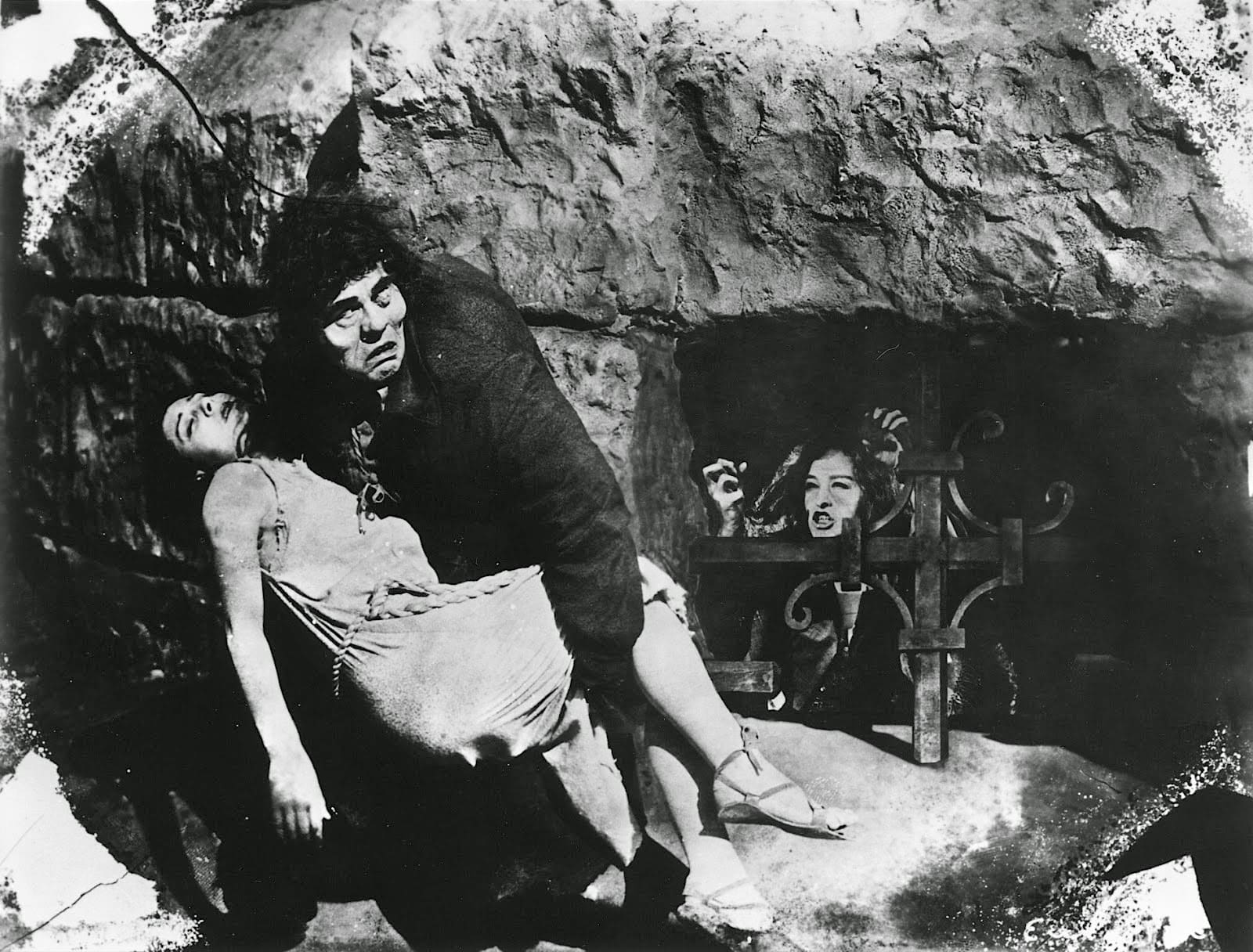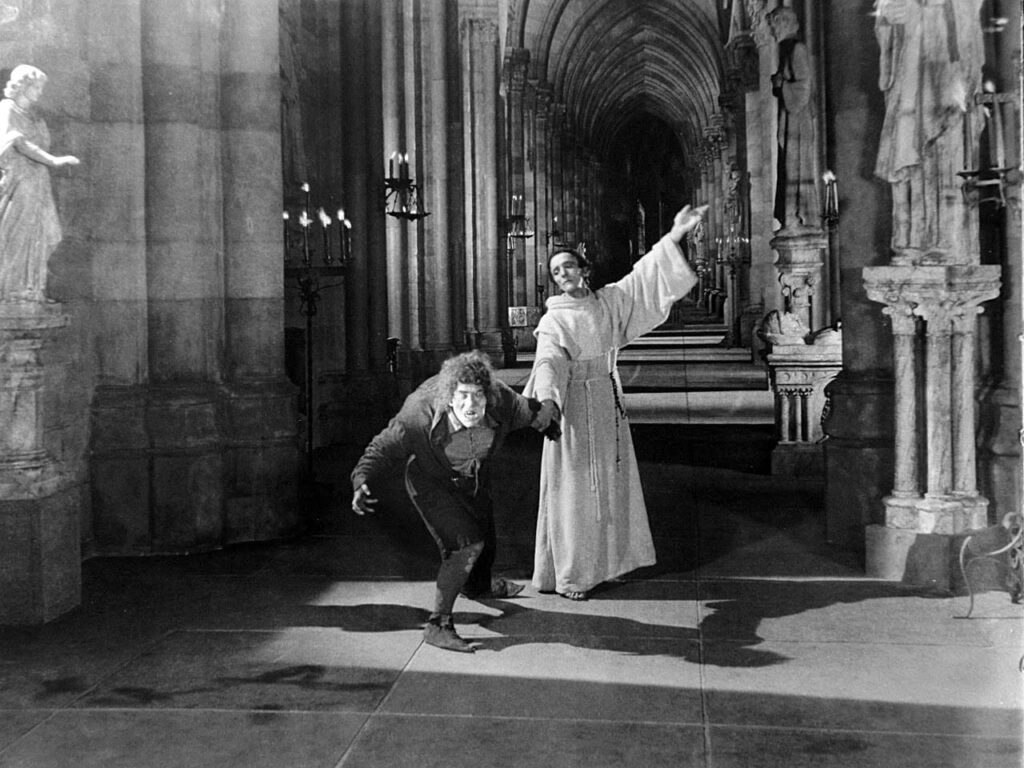Mention The Hunchback of Notre Dame to someone and the response is often a shuffling crouch, accompanied by a moaning “the bells… the bells”, in vague homage to Charles Laughton. Here’s where Laughton got it all from, 1923’s Hunchback, starring Lon Chaney as Quasimodo, the mostly deaf, half-blind unfortunate who falls for a gypsy dancer called Esmeralda, as does nearly every other man in the film.
What’s notable watching this version for the first time is how Esmeralda-centric it is. This is her story, not Quasimodo’s. The title of Victor Hugo’s original novel was Notre-Dame de Paris (Our Lady of Paris), and it’s tempting to imagine the title nods towards Esmeralda – she is a redemptive figure throughout, after all. Maybe it does, but the book was also part of the nascent heritage industry. Hugo wrote it in large part to drum up support for the unloved cathedral and gothic architecture more generally. It was out of fashion at the time and everywhere was being “improved (Notre-Dame’s stained glass windows had been replaced by plain ones, for instance) or pulled down.
This film follows Hugo’s book almost to the letter, brightening up the bleak ending a touch but otherwise staying faithful to the source. Quasimodo (Latin for “half made”) is a hunchback at the Cathedral of Notre Dame whose master, Jehan, (Brandon Hurst) has a thing for beautiful gypsy dancer Esmeralda (Patsy Ruth Miller). Jehan pressures Quasimodo into helping him kidnap Esmeralda for nefarious purposes, but she is saved by the dashing, womanising captain of the guard Phoebus de Chateaupers (Norman Kerry) – an intertitle tells us that “Men yielded to his sword; women to his smile”. Chateaupers initially also fancies having his way with this hot-blooded livewire, but his head is turned entirely by Esmeralda’s purity of heart, nobility of spirit, pluck, vigour and so on, and he falls in love with her.
This sets in train a series of events which take in death, a wrongful arrest, an accusation of witchcraft and Quasimodo swinging in on a rope to save Esmeralda and deposit her in the cathedral, where the medieval notion of sanctuary will protect her… for a while at least.
Esmeralda’s stepfather is the beggar king Clopin, who eventually mobilises Paris’s entire underclass to help her. Everything barrels towards an all-action climax involving giant rocks, rivers of molten lead and a sizeable cast rushing hither and yon.
It’s a grand movie conceived on the biggest scale by Universal, who put everything they had into it in an effort to elevate themselves to the premier league of movie studios. Chaney, already famous for his “cripple” roles, went the extra mile to portray Quasimodo, with a false eye, a wig, false teeth, a plaster hump and hip and shoulder yoked together in a harness to create a hobbling effect. To modern eyes he’s overdoing it and the prosthetics look terrible, but audiences at the time seemed convinced, and it was at least in keeping with the almost recklessly grand production design, on sets on Universal’s back lot that are huge and impressive. Look at that early shot where Quasimodo swings across the cathedral’s front elevation and note the detail of the stonework.
The director is Wallace Worsley, who was chosen by Chaney himself. Though Chaney (a producer in all but name) had originally wanted Frank Borzage, Worsley’s work is stately, his static cameras making the most of the monumental set. Chaney’s performance is selfless and serves the work – he knows that the story is not really about him. As the feisty, beautiful and pure-hearted Esmeralda, Miller is everything she should be, and more, her performance the glue that hold the whole thing together, managing to be both subtle and big at the same time.
The class angle is interesting and adds a subtext – poor=good, rich=bad, for the most part – reflecting the sensibilities of the source material. Hugo also wrote Les Misérables, let’s remember, another epic story fascinated with the vitality of the mob.
As to the 2021 restoration by NBCUniversal, released on Blu-ray by Kino Lorber, it’s been done from the only elements left in existence, the 16mm ones struck for the “show at home” market. It’s good enough to reveal what a brilliantly lit and spectacular-looking film this once was, but the image is soft, the artefacts and damage numerous and there’s 15 minutes missing, presumably gone for ever. Interestingly, the whole film is available, without a soundtrack (so no music), on The Hunchback of Notre Dame’s Wikipedia page.
Talking of which, a big shout to Nora Kroll-Rosenbaum and Laura Karpman’s new score on the Blu-ray, which is dramatic, powerful, vivid and supple. It really adds to the atmosphere and helps transport us back to 1923, when this movie must have left audiences with their mouths hanging open in awe. It’s still hugely impressive today.
The Hunchback of Notre Dame – Watch it/buy it at Amazon
I am an Amazon affiliate
© Steve Morrissey 2023


